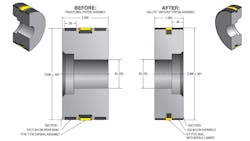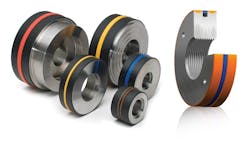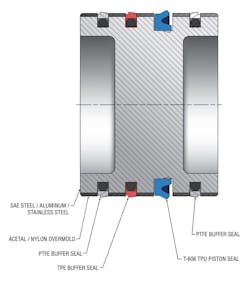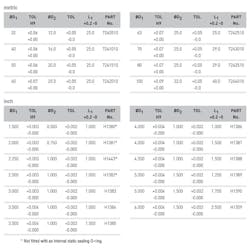Unitized piston breathes life into heavy-duty hydraulic cylinder applications
Original equipment manufacturers (OEMs) in construction, deep sea, off-highway, forestry and agricultural markets experience many challenges. By nature of the work performed by the equipment used in these markets, they face some of the most demanding hydraulic cylinder system applications, off-duty cycles, temperatures and pressure requirements.
Another challenge is to maintain an extremely short piston or gland design while maximizing side load protection and protecting sealing elements from contamination and failure caused by extrusion. And every OEM designing for heavy-duty cylinder work is interested in components with increased capacity for high-temperature, high-pressure environments. They also want to extend cylinder performance life while reducing premature failures and manufacturing warranty and assembly costs. And equally important is a solution that is easy to use, service and retrofit in a wide range of sizes and seal materials.
Unitized and multipart assembly compared
Since its introduction to the market more than two decades ago, the one-piece or unitized piston solves many of the design challenges presented by the multicomponent product. Over the years, the unitized piston has evolved in versatility from a custom designed solution limited to less than five sizes for specific automotive and agricultural market needs to more than 650 unique production sizes up to 14 inches in diameter for a wide range of applications across various markets.
Today’s unitized piston performs well beyond the multipart piston that typically requires assembly of numerous seals and wear rings. Appropriate for light and heavy-duty functions, the unitized piston is particularly suited for high-pressure environments because of its ability to perform at 5,000 to 10,000 psi (345 to 690 Bar) continuously. It also offers built-in performance advantages not available with the multipart piston, such as a tightly controlled tolerance to reduce the number of critical performance variables.
Additionally, the simplicity of receiving one or two parts — if unitized piston and glands are provided — solves age-old logistical challenges associated with multipart piston and gland assemblies. Consider the unitized product’s main design and physical aspects along with a few examples of how it is used by OEMs to boost performance and extend the life of critical equipment used by industry every day.
Design
The unitized product (gland or piston) is a complete, self-contained and ready-to-fit bearing and seal in one assembly with a composite bearing material molded over or through-molded on the critical diameter. The assembly is then finished-machined to provide a tight tolerance with the mating rod or cylinder bore (usually 0.001 to 0.005 inches from the mating surface). Molding the bearing material and then precision machining gives an extremely tight fit between the piston bore and/or the rod diameter. The diameter is tightly controlled, reducing the number of critical tolerance variables (stackups) to result in increased performance.
Because the piston is through-molded with composite bearing material and then finished-machined, the result is the greatest bearing area achievable while holding the original dimensional restrictions. Tight tolerance machining helps prevent large metal-to-metal gaps by which a seal may extrude.
Sizes & materials
Some examples of the standard metric and inch sizes available for the unitized piston are included in Table 1. In addition, custom unitized pistons can be designed to fit a specific need.
Designs generally represent a specific customer’s application needs. The nonmetallic bearing material, typically constructed of high-compressive strength composite wear material like GF Nylon, is sealed with a quality sealing element molded to the piston and machined to the final precise outside diameter dimension.
Applications
The unitized piston works universally well in most hydraulic cylinder applications. However, the product has been especially successful when used in heavy-duty applications like grapples, shearers and light-duty environments for things like agricultural seeding and several pneumatic designs. Following are a few examples.
Grapple/shearer: In grapple and shearer applications, heavy side load, heat generation and pressure spikes are the norm. The unitized product allows an engineer to address these concerns by taking advantage of the significant side load protection (when compared to the non-unitized alternative) without having to redesign the original piston and gland envelop to allow for more bearing area.
The designer can maintain the existing design envelope while upgrading the cylinder performance. Thus, the upgrade is retroactive for a product that exists in the field already and is a big improvement for new cylinders. In addition, the tight extrusion gaps provided by the unitized piston and gland help increase seal life by reducing the number of contaminants that reach the seals and prevents extrusion of the seal during high cyclic usage.
Pneumatic: Unitized pistons can be used in full pneumatic applications or hybrid pneumatic hydraulic applications. To address the latter, an accumulator piston is used. The accumulator piston is typically designed with an aluminum base overmolded with a high-quality resin. This creates a 100-percent bearing surface, eliminating the possibility of metal-to-metal contact and ensuring that no material swell will occur because of moisture ingression. Other base accumulator materials are available, including stress-proof steel and multiple grades of stainless. Sealing packages for the unitized accumulator can be tailored to each specific application. As depicted in Figure 3, single- and multiseal systems can be arranged.
Seeding: In a seeding application, the unitized piston provided a customer with two upgrade opportunities: (1) reduction of the overall length of the piston to gain cylinder stroke length and (2) ability to use a less complicated and less expensive piston seal to pass internal ports in the cylinder. A piston design was proposed that reduced overall length while maintaining the existing bearing protection. The piston’s tight fit to the cylinder bore protected the seal from contamination and extrusion when crossing internal ports. Finally, the piston’s unique design features helped control fluid flow into the internal ports – a problem the customer was unable to address until the unitized piston became an option.
Ultra-high speeds: A customer application required a sealing process that would be used in a repeatable fashion at ultra-high speeds (20 feet/second+). Using a custom sealing system and an extremely tight fit to the cylinder bore, the required speed and durability were achieved. The tight-fitting bore combined with the design team’s system approach to addressing the issue allowed the seals to survive at high speeds and multiple uses with no visible damage or performance depletion. Repeatability was especially important because the equipment was used in an environment in which repair and rebuilding were not feasible.
Ryan Webster is director of engineering for Hallite, where he manages the company’s seal design and development activities. His previous positions at Hallite include engineering group leader, lead engineer for OEM customers and senior applications engineer. Webster is a graduate of Lawrence Technological University. Contact him at [email protected].





